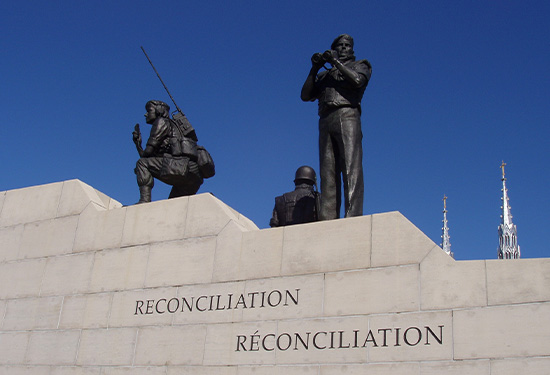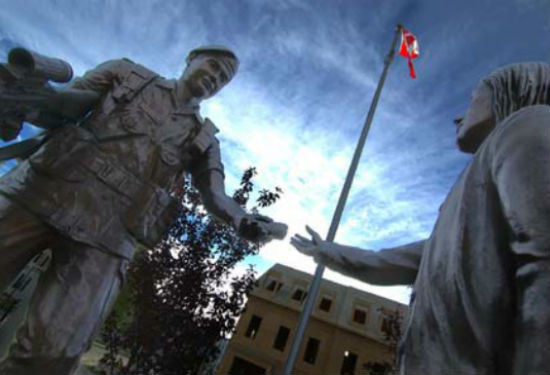Order of events
Post-Second World War
Ethiopia and Eritrea unite politically.
1983
Major famine begins in Ethiopia.
1985
Canadian Armed Forces send medical team and relief supplies to Ethiopia.
1988
Canadian Armed Forces airlift humanitarian supplies to Ethiopia.
1991
Canadian military planes deliver 33 million tonnes of food to Ethiopia.
1993
Eritrea becomes an independent country after a violent civil war.
1998
Renewed clashes begin between Ethiopia and Eritrea.
2000
Ceasefire is declared. Canadian and other United Nations peacekeepers arrive.
2001
Temporary security zone is established between Ethiopia and Eritrea.
2003
Canadian peacekeepers leave the region.
2018
Formal declaration signed. This ends the dispute between the two countries. The region is still volatile.
Classroom materials
Canadian Armed Forces members served in a United Nations (UN) peace mission to Ethiopia and Eritrea from 2000 to 2003. At times, more than 500 Canadians served in these major efforts. Some Canadian military personnel also took part in humanitarian aid missions to the region during the 1980s.
Ethiopia and Eritrea
Ethiopia and Eritrea are neighbouring nations in the easternmost corner of Africa. This region, commonly called the Horn of Africa, has endured frequent drought and strife for decades.
Ethiopia is the oldest independent nation in Africa. This large, ethnically diverse country has an area of more than 1.1 million square kilometres (about the size of the Northwest Territories). It has a population of more than 120 million people.
Eritrea is a small, largely rural country just north of Ethiopia along the shores of the Red Sea. It is about 120,000 square kilometres (roughly twice the size of Nova Scotia) and has a population of about four million people.
Following the Second World War, Ethiopia and Eritrea became part of one larger country. However, many people in Eritrea wanted independence. There were periodic revolts, resulting in decades of violence.
Famine
A major drought and famine ravaged Ethiopia from 1983 to 1985. This humanitarian crisis prompted a large international response. In early 1985, the Canadian Armed Forces sent a 20-person medical team and 30 tonnes of relief supplies there. In 1988, two Canadian military Hercules aircraft and their crews airlifted more than 8,000 tonnes of emergency relief supplies to Ethiopia. Severe droughts continued in the region during this period.
Three years later, in 1991, Canadian Armed Forces members returned to deliver humanitarian aid again. Three Canadian Hercules aircraft and more than 240 personnel delivered 33 million tonnes of food aid.
Eritrea becomes independent
After a major civil war, Ethiopia finally dropped its claims to Eritrea in the early 1990s. Eritrea became independent in 1993—but this did not end the unrest. Arguments about the defined border between these countries continued to cause major friction.
In 1998, clashes broke out again. Ethiopia and Eritrea built up hundreds of thousands of troops along their shared border. By 1999, they were locked in fierce fighting that turned into trench warfare. A ceasefire was declared in 2000. By then, more than 100,000 soldiers and civilians had died. Another 650,000 people became refugees in the region. The countries finally reached a peace agreement by the end of that year, but tensions on the ground were still high.
Canada and the world responds
A UN peace effort was established in Ethiopia and Eritrea to monitor the terms of the new peace treaty. Multinational peacekeepers maintained a 25 kilometre-wide temporary security zone between the two countries until they could agree upon a final border.
Canada was an early contributor to the peacekeeping efforts in the region. In late 2000, 450 Canadian troops deployed there for six months to help establish the UN mission. Canada provided armoured reconnaissance, mechanized infantry, an engineer troop and support elements.
The Canadian contingent deployed with troops from the Netherlands and Denmark. These countries were part of the UN Standby High-Readiness Brigade. This multinational force was created in 2000 to respond quickly to trouble spots around the globe. It was designed to deploy for six months to allow time for the UN to organize full follow-up missions.

Establishing a security zone
The Canadians were part of the first UN battalion to become fully operational in Ethiopia and Eritrea. They set up checkpoints and bases in important areas. Their first major task was to ensure the two sides withdrew from the disputed area to create the temporary security zone. That delicate process took three months.
Canadian troops frequently patrolled the countryside in their light armoured vehicles. They sometimes had to confront the Ethiopian and Eritrean forces who were raiding abandoned villages in the security zone. Each group was looking for supplies to build new defence locations on their side of the border.
The opposing forces eventually withdrew to the agreed positions. In April 2001, the temporary security zone was firmly in place. The Canadians continued to monitor the area. In June 2001, at the end of their six-month deployment, most of the Canadian peacekeepers began to return home.

A Canadian and UN presence continues
At times in the early 2000s, the UN mission in Ethiopia and Eritrea had more than 4,000 military personnel and 450 civilians. These peacekeeping personnel came from over 40 countries.
A smaller contingent of six Canadian peacekeepers also formed part of a group of 220 UN military observers. Their job was to continue monitoring the security zone and make sure both sides complied with the peace treaty terms. They also consulted the local people to find out their needs for humanitarian assistance. This Canadian presence in the region continued until July 2003.
Uneasy peace
International peacekeepers prevented any further major conflict between Ethiopia and Eritrea. Despite this, the border situation stayed complicated. It took until 2018 for the two countries to sign a formal declaration ending their disputes. Ethiopian Prime Minister Abiy Ahmed won the Nobel Peace Prize in 2019 for his efforts. However, the countries have yet to fully carry out the terms of the agreement.
The region is still volatile. A rebellion erupted in the Tigray area of northern Ethiopia in late 2020. Human rights concerns and ongoing drought intensify the situation.
Dangerous service and selfless giving
Canadian service members endured many hardships while on peacekeeping duties. In Ethiopia and Eritrea, the temperatures often reached 50 degrees during the day. Without any breeze at night, the high humidity made sleeping difficult. Flies were everywhere. The long drought in the area also created a fine, powder-like dust that coated our soldiers.
Canadian troops carry out their official peacekeeping duties with skill and courage. They also go above and beyond the call of duty, on their own time. In Ethiopia and Eritrea, our peacekeepers planned, carried out and paid for many humanitarian efforts themselves. They distributed clothes, school supplies, sports equipment and toys to local children. Canadians also volunteered to help locals rebuild a damaged school in an Eritrean town.
Sacrifice
Ten UN personnel from six different countries died during the international peace efforts in Ethiopia and Eritrea. Fortunately, no Canadian Armed Forces members lost their lives during this mission. Sometimes, they faced hostile fire and landmines, which damaged some Canadian military vehicles.
- Date modified:

















